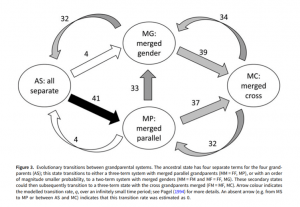The VariKin project has examined the cultural evolution of kinship terminology from a range of perspectives and methods. Considerable research by our group and others has focused on the comparison of cousin and sibling terms, but grandparent terms, the topic of this paper, are largely understudied. The social salience of grandparents, due to their frequent role in the care of grandchildren as well as in controlling wealth and cultural knowledge, suggested that a project of this focus was long overdue.
Catherine Sheard and Fiona Jordan from the VariKin team, along with Claire Bowern and Rikker Dockum (Yale University), addressed this gap in an open access paper published earlier this year in Evolutionary Human Sciences. “Pama–Nyungan grandparent systems change with grandchildren, but not cross-cousin terms or social norms” compares grandparent terms across 134 Australian languages from the Pama-Nyungan family. Using Pama-Nyungan as a study system is less common in studies of kinship macroevolution. Australia’s ecological and anthropological history (namely, a continental radiation of primarily hunter-gatherer languages) provides a contrasting example to language families associated with agricultural spreads, such as Austronesian or Bantu.
A standard way of thinking about grandparental kin terms is to consider each of parent of mother and father: MM, MF, FM, and FF. Pitjantjatjara has a two-term system that merges gender like English does, with ‘kami’ for MM and FM (grandmother), and ‘amu’ for FF and MF (grandfather). Other languages have four separate terms, for example, Alyawarra has ‘arrenge’ FF, ‘artartetye’ MF, ‘anyanye’ MM and ‘aperle’ FM. Pama-Nyungan languages also explore other three-term systems that merge parallel grandparents, so that MM=FF as in Djapu, or merge cross grandparents, so that MF=FM, as in Yagara.
The group used Bayesian phylogenetic comparative methods to model the stages of grandparent naming systems (see Fig 3. below). This analysis suggests that the ancestral, proto-Pama–Nyungan system had four separate terms (on the left of the diagram below). In different groups of languages, this shifted to either a two-term system (merging sexes, like English), or a three-term system merging parallel grandparents (MM=FF), with a potential third stage (merging cross, MF=FM) emerging in some cases from there. Note that some of these transitions seem to have occurred without a stable intermediate state.
As well as making discoveries regarding systems of grandparental terminology, Catherine and colleagues note that we still do not know why it is that these systems transitioned in that particular order. In their paper, the authors tested potential social factors that might drive these transitions (community marriage organisation, and post-marital residence) but found no significant correlations. There was minimal co-evolution with the rest of the terms in the kinship system, and it remains an open question what linguistic or social forces shape grandparent terms.

